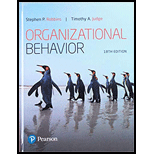
To determine:
The three components of attitudes
Introduction:
An Attitude is a learnt tendency to evaluate things in a certain way. These things includes but not limited to people, places, products etc. Attitudes are formed based on three components, namely Affective component, Behavioral component and Cognitive component. This is also known as the ABC of attitude. These three components in combination will create an individual’s attitude towards a certain person or an object.
Explanation of Solution
Affective component refers to the emotional aspect of the attitude. It is about those emotions that are attached with the object. Emotions are mental activities based on conscious experiences and include things such as fear, happiness, anger etc. The affective component will shape our attitude towards a certain thing. E.g.-: “I am afraid of spiders”, fear is an affective component and this emotion will force the individual to have a displeasing attitude towards spiders.
Behavioral component refers to those actions and behaviors, one would demonstrate as a result of the attitude formed. These can be physical behaviors such as running, shouting or screaming when spiders are seen or non physical behaviors such as avoiding spiders.
The cognitive component refers to the mental process of acquiring knowledge and information about a certain object that will shape our attitude. This may be influenced by our learning, beliefs, and experiences. For e.g.-: I have seen how painful spider bites can be on TV therefore; i know that they are dangerous.
Individuals form attitudes for everything around them; it helps us to create our perception about the surrounding. An attitude is formed based on an individual’s knowledge about the object (cognitive), combined with their emotional reactions (affective) and their actions toward that object (behavioral).
Want to see more full solutions like this?
Chapter 3 Solutions
EBK PEARSON ETEXT ORGANIZATIONAL BEHAVI
- Describe the conflicting motivations in the mixed motive nature of negotiation.arrow_forwardDo you think that the use of Charts and Graphics is important in your career?arrow_forwardExplore the significance of data in the decision-making process. Share a mock scenario or a real-life experience where data played a crucial role in making informed decisions. Use a video or interview to present different perspectives on how data-driven decisions can impact outcomes. Analyze the limitations and potential biases associated with relying solely on data for decision-making and suggest strategies to mitigate these challenges.arrow_forward
- Please original work How can business analytics (BA) methods such as Online Analytical Processing (OLAP), data visualization, and multidimensionality enhance decision-making processes within an organization? How can management support system (MSS) modeling, when integrated with spreadsheet tools, be applied to solve real-world business challenges? Provide examples from industries where BA and MSS have significantly impacted organizational strategy. Please cite text references and add weblinksarrow_forwardBased on the case study Develop a high-level or summary: Human Resource Management Planarrow_forwardBased on the case study Develop a high-level or summary: Risk Management Planarrow_forward
- You are the newest member of an international HR staff at Transnational Electronics (TE). Your manager wants to improve productivity in the Delhi, India factory, where two hundred (200) are employed. Your boss has proposed rank ordering (top to bottom) each department’s employees based on their demonstrated performance and laying off the bottom 15% within 30 days from today. The employment seniority distribution is: 25 + years 101 10 to 24 40 5 to 9 16 4 years 8 3 years 9 2 years 12 1 year 8 1 - 11 months 6 What should be the human resource strategy and response be on this topic?arrow_forwardwhy are global company layoffs so difficult to do?arrow_forwardBuilding a reputation and business overseas will take time. Having a clean public image will help recruit potential employees internationally. How can the president of a small company be sure of this?arrow_forward
- International assignments often fail due to cultural, political, legal, and economic differences between countries. These differences can have an impact on how employees adjust to their new environment and how effectively they can manage these new relationships. I need help to elaborate thisarrow_forwardYou are the newest member of an international HR staff at Transnational Electronics (TE). Your manager wants to improve productivity in the Delhi, India factory, where two hundred (200) are employed. Your boss has proposed rank ordering (top to bottom) each department’s employees based on their demonstrated performance and laying off the bottom 15% within 30 days from today. The employment seniority distribution is: 25 + years 101 10 to 24 40 5 to 9 16 4 years 8 3 years 9 2 years 12 1 year 8 1 - 11 months 6 Assuming that the potentially affected employees' daily compensation is the equivalent of $35.00 USD, what is the cost of implementing this reduction?arrow_forwardyour manager wants to improve productivity in the Delhi, India factory, where two hundred (200) are employed. Your boss has proposed rank ordering (top to bottom) each department’s employees based on their demonstrated performance and laying off the bottom 15% within 30 days from today. The employment seniority distribution is: 25 + years 101 10 to 24 40 5 to 9 16 4 years 8 3 years 9 2 years 12 1 year 8 1 - 11 months 6 What are the major issues faced by the firm in regards to this proposal based on Indian labor laws?arrow_forward
 Understanding BusinessManagementISBN:9781259929434Author:William NickelsPublisher:McGraw-Hill Education
Understanding BusinessManagementISBN:9781259929434Author:William NickelsPublisher:McGraw-Hill Education Management (14th Edition)ManagementISBN:9780134527604Author:Stephen P. Robbins, Mary A. CoulterPublisher:PEARSON
Management (14th Edition)ManagementISBN:9780134527604Author:Stephen P. Robbins, Mary A. CoulterPublisher:PEARSON Spreadsheet Modeling & Decision Analysis: A Pract...ManagementISBN:9781305947412Author:Cliff RagsdalePublisher:Cengage Learning
Spreadsheet Modeling & Decision Analysis: A Pract...ManagementISBN:9781305947412Author:Cliff RagsdalePublisher:Cengage Learning Management Information Systems: Managing The Digi...ManagementISBN:9780135191798Author:Kenneth C. Laudon, Jane P. LaudonPublisher:PEARSON
Management Information Systems: Managing The Digi...ManagementISBN:9780135191798Author:Kenneth C. Laudon, Jane P. LaudonPublisher:PEARSON Business Essentials (12th Edition) (What's New in...ManagementISBN:9780134728391Author:Ronald J. Ebert, Ricky W. GriffinPublisher:PEARSON
Business Essentials (12th Edition) (What's New in...ManagementISBN:9780134728391Author:Ronald J. Ebert, Ricky W. GriffinPublisher:PEARSON Fundamentals of Management (10th Edition)ManagementISBN:9780134237473Author:Stephen P. Robbins, Mary A. Coulter, David A. De CenzoPublisher:PEARSON
Fundamentals of Management (10th Edition)ManagementISBN:9780134237473Author:Stephen P. Robbins, Mary A. Coulter, David A. De CenzoPublisher:PEARSON





